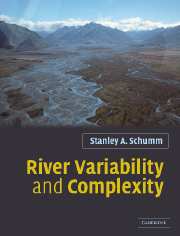Book contents
- Frontmatter
- Contents
- Preface
- Acknowledgments
- Part I Background
- Part II Upstream controls
- Chapter 4 History
- Chapter 5 Tectonics and relief
- Chapter 6 Lithology
- Chapter 7 Climate: hydrology
- Chapter 8 Humans
- Part III Fixed local controls
- Part IV Variable local controls
- Part V Downstream controls
- Part VI Rivers and humans
- References
- Index
Chapter 6 - Lithology
Published online by Cambridge University Press: 05 June 2012
- Frontmatter
- Contents
- Preface
- Acknowledgments
- Part I Background
- Part II Upstream controls
- Chapter 4 History
- Chapter 5 Tectonics and relief
- Chapter 6 Lithology
- Chapter 7 Climate: hydrology
- Chapter 8 Humans
- Part III Fixed local controls
- Part IV Variable local controls
- Part V Downstream controls
- Part VI Rivers and humans
- References
- Index
Summary
Lithology obviously affects runoff and sediment yield and therefore, it is an upstream control (Figure 1.2). For a given relief, sound rock will yield less sediment, but shattered rock will cause mass movement and the delivery of large quantities of sediment to the main streams. As considered previously, the type and amount of sediment delivered to a valley can determine the type of channel found there, as well as the variable morphology and behavior of the channel.
Schumm (1960, 1961) argued that, at least for sand-bed rivers, those draining from shale or siltstone areas will have a high percentage of silt and clay in banks and bed, and they will be narrow, deep and sinuous, whereas those draining from sandy and gravel areas will be wider and shallower, and relatively straight. A good example of this is provided by the Kansas River system in Colorado and Kansas.
The Kansas River (Figure 1.3) is formed where the Smoky Hill and Republican Rivers join in central Kansas. The Smoky Hill River in its headwaters drains sandy sediment, as does the Republican River. However, the Smoky Hill River is joined by two large tributaries, the Saline and Solomon Rivers that drain from Cretaceous shales. Moving downstream from a small upstream tributary of the Smoky Hill River (Figure 6.1, Site 32), the channel is very sandy (Sites 32–37) and width increases dramatically, but depth only doubles.
- Type
- Chapter
- Information
- River Variability and Complexity , pp. 59 - 63Publisher: Cambridge University PressPrint publication year: 2005



